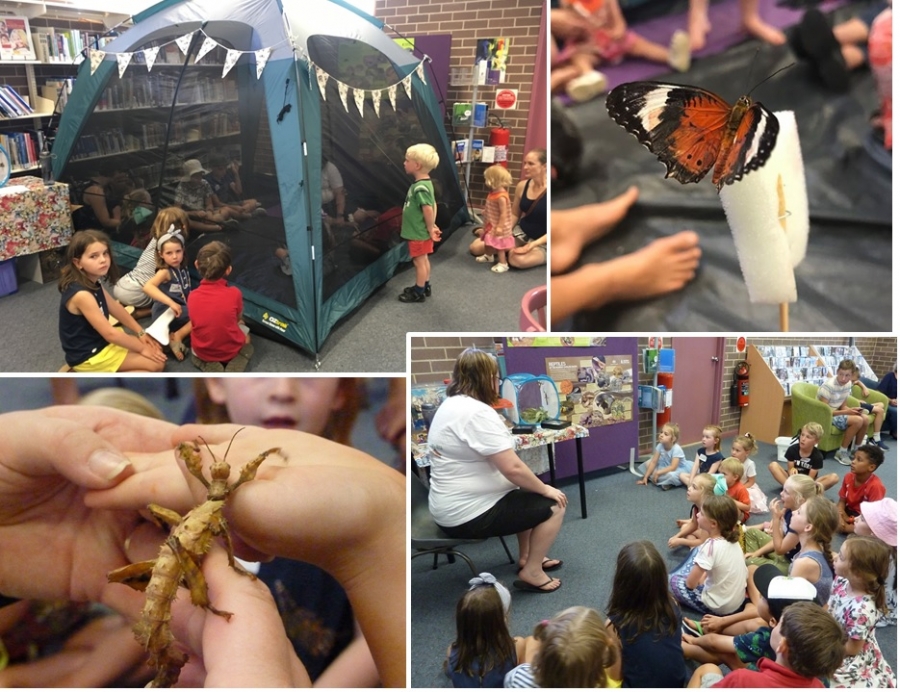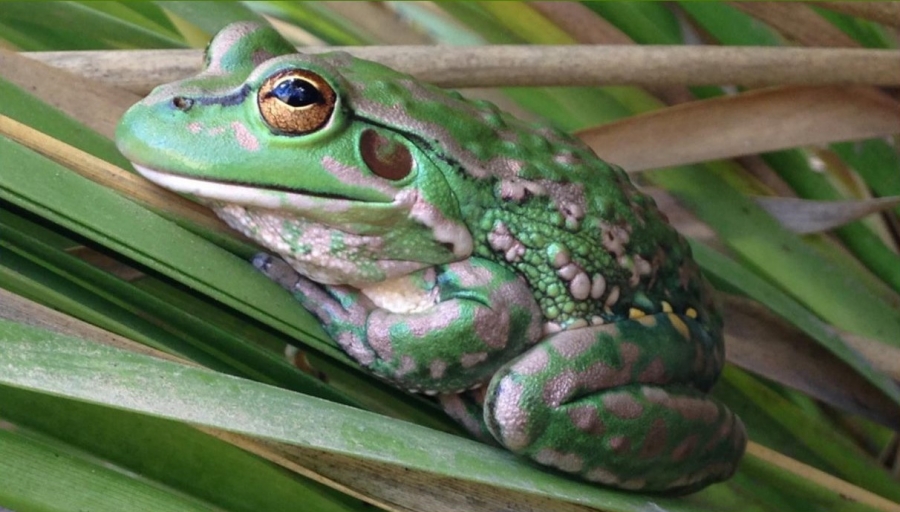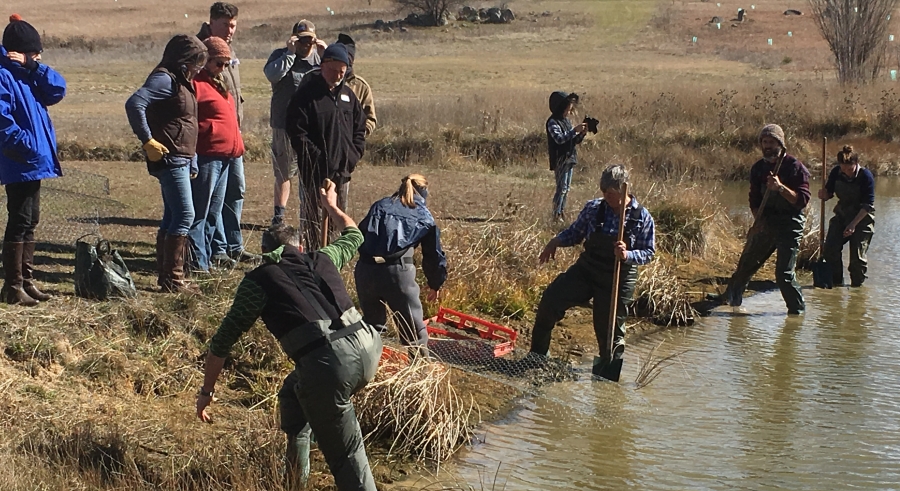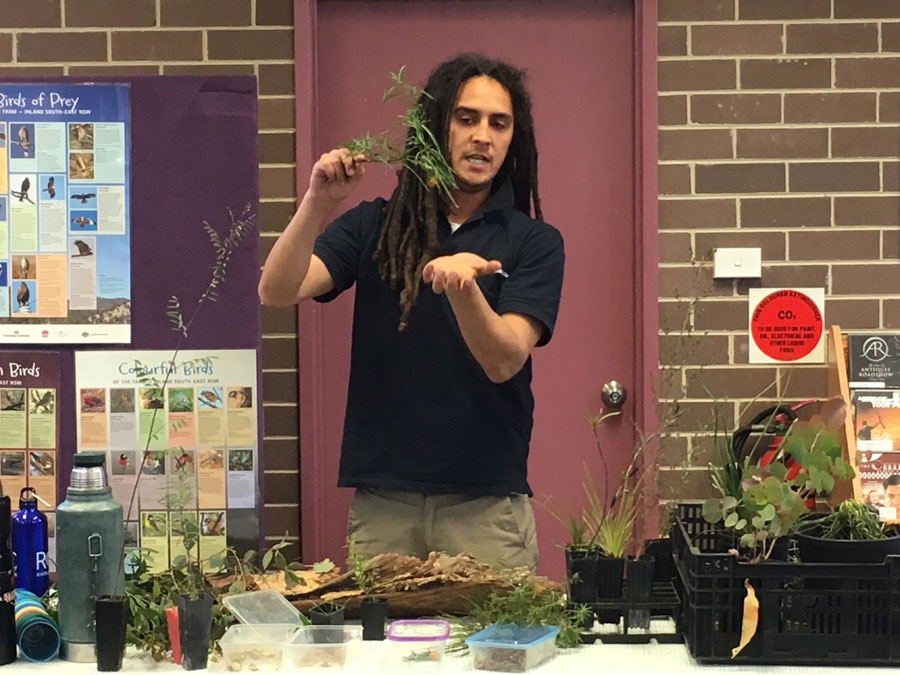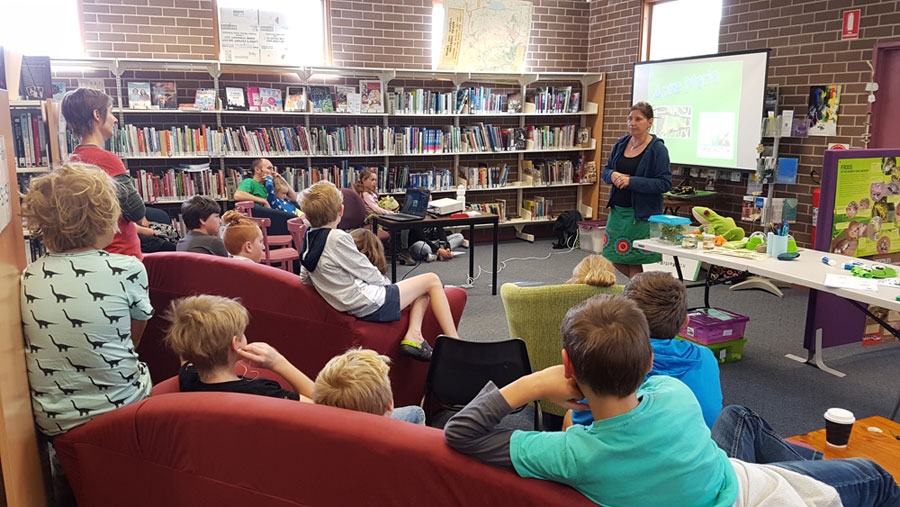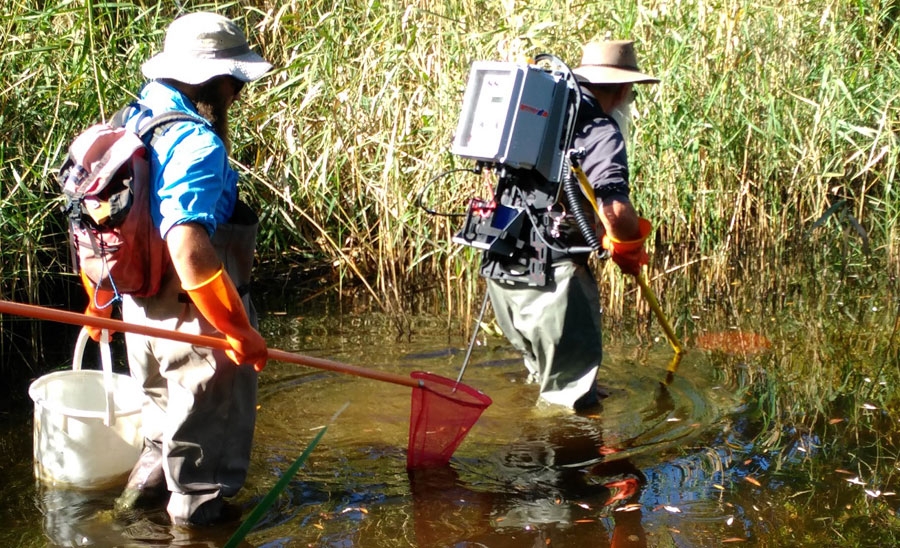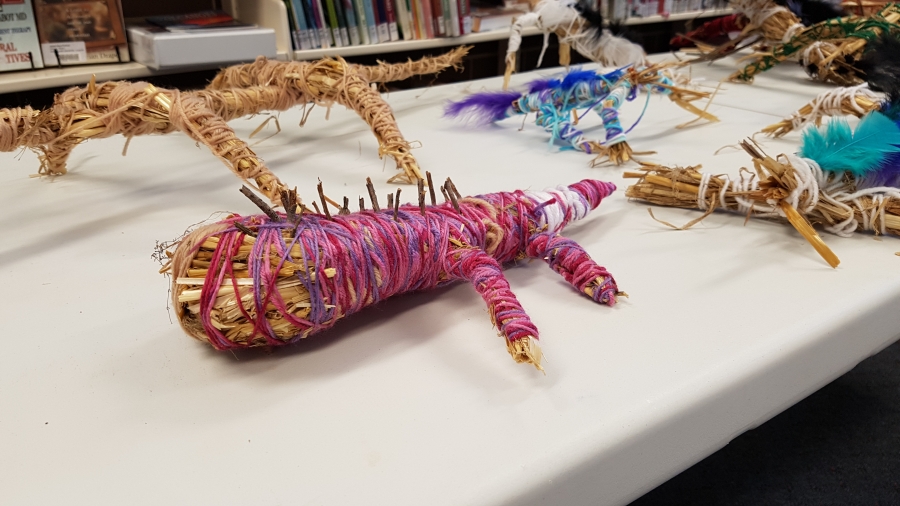Butterfly and Bug Experience
The Gunning Library was buzzing with delighted children, parents and grandparents at the ‘Butterfly and Bug Experience’ School Holiday Activity on 22nd January. Not even a snake spotted outside the library on the previous day put a dent in the large turnout. Young and old alike lined up for the chance to feed butterflies in a special butterfly tent, before we all got up close and personal with a range of amazing bugs. Tegan, the presenter, kept the scorpion and Australian Tarantula safely in their transparent containers while showing them around. But most other creatures – including a Spiny Leaf Insect and a Giant Rainforest Millipede – were crawling over hands and limbs of fascinated children. The hermit crabs were real characters and a big hit (with me at least!). Tegan mentioned this excellent short David Attenborough feature on a hermit crab shell exchange that is well worth watching. With the alarming decline in invertebrate (especially insect) species and numbers, this activity provided an important opportunity for children and their parents to gain some familiarity and overcome some fears of the various creepy crawlies that are critical to healthy functioning ecosystems.
A big thank you to Bianca and the Gunning Library for hosting yet another one of our School Holiday Activities. And thanks to Ellie Vivas for the great close-up shot of the butterfly.
The fascinating tale of the Yellow-spotted Bell Frog
At Gunning District Landcare’s AGM on Wednesday 14th November, we heard a fascinating presentation from Taronga Zoo’s Michael McFadden about his team’s work to bring the local Yellow-spotted Bell Frog back from the brink of extinction. Michael explained how the Yellow-spotted Bell Frog was once found across a large area of NSW, but from around 1980 the species was assumed to be extinct – largely due to the devastating impact of the chytrid fungus. But then in 2009, an individual frog was spotted on Blakney Creek (north west of Gunning and Dalton) by Luke Pearce of NSW DPI Fisheries who was out surveying for Southern Pygmy Perch. Luke reported his find to frog guru Dr David Hunter, and the pair returned to the area to confirm that the species was living there. This was an extremely exciting find, and there was no question that the amphibian team at Taronga Zoo would attempt to establish an ‘insurance colony’ from a small number of tadpoles and juveniles collected from Blakney Creek. It took seven years of trial and error before the team was able to create just the right conditions for the frogs to breed at the zoo (it turns out they are very fussy!). In early 2017, there was finally hundreds of new frogs, many of which were released back into their natural environment. The breeding program for Yellow-spotted Bell Frogs at Taronga Zoo is on-going. There are more planned frog releases around Blakney Creek and elsewhere, as well as active monitoring to see how well the released frogs survive in the wild.
If you think you have heard or seen this frog near you, we would be very happy to put you in touch with the friendly frog experts (they would love to hear from you!) – but it will be best if you can get a photo (the Yellow-spotted Bell Frog is one of the few green-coloured frogs you are likely to see in daylight), or get a recording of their call. If you have a smart phone we highly recommend the FrogID app developed by the Australian Museum.
2018 New Life Member
At Gunning District Landcare's 2018 AGM, Janet Heffernan was recognised with an honorary life membership for her unflagging contribution to sustainable land management, Landcare, and the local community.
Janet joined Jerrawa Creek Landcare Group (JCLG) in late 2003 and remained an active member until it merged into GDL. Bob Spiller recounts Janet’s involvement with JCLG: “She came to the fore particularly in seeing something needing to be done and either bringing it to the attention of a committee member and, not infrequently, then making it happen”. Janet served as Secretary on the Upper Lachlan Landcare committee, and since the end of 2015, has been a prominent committee member of GDL.
Janet has been the driving force behind many activities undertaken by GDL, and is renowned for her hands-on and practical approach to conservation and sustainable land management.
Janet has a passion for looking after threatened species in the region. She has initiated the implementation of some of the key recommendations from GDL’s Southern Pygmy Perch Action Plan; including helping to organise fish monitoring, habitat mapping, the establishment of refuge dams, and training landholders in the art of planting and protecting aquatic plants. Janet is also actively helping to ensure the survival of Superb Parrots by planting scores of single paddock trees on ‘Moorlands’ and generously sharing her knowledge with other landholders.
Janet takes a keen interest in providing activities and resources for children and the broader community. She is strongly engaged in GDL’s School Holiday Program, has run an activity with the local Scouts, assisted with the Dalton School Bush Block and rehabilitation of Oolong Creek, and is always on the lookout for relevant books to contribute to the local library – which now has a rich collection of donated resources available to the public.
On top of all this, in various ways Janet has facilitated the planting of tens of thousands of trees and plants in local landscapes. She regularly attends events run by neighbouring Landcare groups, is a keen bird watcher and member of the Crookwell Native Flora and Fauna Club. It is difficult to imagine where she finds time to also create her beautiful patchwork quilts!
Janet has committed countless hours in working towards improving outcomes for biodiversity, land, water and people across the district. For all this work, Gunning District Landcare is sincerely grateful.
The Wonder of Waterbugs
Gunning District Landcare’s latest school holiday activity on ‘Waterbugs’ had everyone captivated. The tranquil waters of Meadow Creek yielded an impressive range of weird and wonderful critters, including fresh water shrimp, baby yabbies, snails, blood worms, ‘fluffy bums’ and lots more. After an introductory chat in Gunning Library, most of the session was spent in Barbour Park, where aquatic ecologist Cecil Ellis demonstrated how to catch and identify waterbugs. Cecil was very impressed with level of keen interest among all participants, who ranged from 7 to 15 years old. The more tech-savvy amongst the group were quick to find their way around The Waterbug App, which is freely available to download to smart phones and other digital devices. Cecil explained that monitoring waterbugs is an important way to gauge the health of rivers and other waterways. The National Waterbug Blitz is a citizen science initiative that has begun this year, and everyone is welcome to take part. It is a great way to contribute to practical environmental science, and as we discovered last week, getting to know waterbugs is also heaps of fun!
At the end of the activity, all waterbugs were released safely back into the Meadow Creek.
A big thanks goes to Cecil Ellis, Gunning Library for hosting these activities, Janet Heffernan for suggesting the activity and providing the yummy snacks, and Acciona Energy for providing funding.
Aquatic Plants for Healthy Dam Habitats
Wild windy weather did not hamper enthusiasm at the Aquatic Plant Workshop on 11th August. Janet Heffernan, committee member of Gunning District Landcare, led the workshop and inspired participants with her ‘get-in-there-and-have-a-go’ approach to planting and protecting aquatic plants. The day was aimed at equipping people with the skills and confidence to improve the biodiversity and habitat values of their dams (which also results in improved water quality for stock and domestic use).
The day started at the Gunning Golf Course where several people donned waders and ventured into one of the dams to get their hands wet and dirty planting in the mud. Others were busy with pliers and wire netting, making up cages to protect the new plants from the destructive habits of water birds. Following a delicious sausage sizzle provided by the Lions Club of Gunning, we drove to Janet’s property to see the impressive work that she has been doing on her dams. There was a high level of interest throughout the day, and as one participant said at the end: “I can't wait to get stuck into my own project now!!”
With a mix of submerged, emergent and ephemeral plants, healthy dams can become important refuges for local native fish, frogs and other wildlife. The Southern Pygmy Perch is one species that will benefit from Gunning District Landcare’s ‘refuge dam’ project; funds have been provided to a number of landholders to establish appropriate aquatic and terrestrial plants, and fence off from stock where necessary. These dams will then be able to host populations of the threatened fish if needed.
A big thanks to Janet Heffernan, the Gunning Golf Course, the Lions Club of Gunning, and all the wonderful participants on the day!
Ngunnawal Bush Tucker School Holiday Activity
In the last week of school holidays, an enthusiastic group of children and a handful of parents gathered in the Gunning Library to learn about Ngunnawal bush tucker from Aaron Chatfield of Greening Australia.
Over tens of thousands of years, Indigenous people in this region have acquired an intimate knowledge of the plants, animals and landscapes that sustain their lives and culture. And as we discovered, children and adults alike in the Gunning district are eager to learn about how they can identify the native foods that grow on their farms and in their gardens.
Aaron displayed and talked us through a variety of Indigenous plants and tools, before offering samples of some delicious morsels. Roasted Bulbine and Chocolate Lily roots were popular, as was the Hardenbergia tea. The Mountain Pepper had a few people hopping on the spot! The children then helped to plant out a bush tucker garden between the library and the post office – keep your eye out as the plants grow bigger through the spring. Soap from Blackwood wattle leaves helped to clean dirty hands, and there were plenty of smiles as everyone left with a Chocolate Lily to plant in their own gardens.
An extra treat on the day was the presence of Aaron’s father, Greg Chatfield. Greg was involved in the production of the excellent book ‘Ngunnawal Plant Use’, two copies of which are now in Gunning Library.
Many thanks to the Gunning Library stuff who are unfailing friendly and helpful!
How truly wondrous are frogs!?!?
Anke Maria Hoefer from Frogwatch ACT had us all captivated with her interesting, entertaining and interactive presentation on frogs. Around 15 children and a handful of adults learned all about frogs’ lifecycle, everything frogs need to lead healthy lives, and what we can do to help look after them.
We heard how frogs use their eyes to ‘stamp’ on the food in their mouths; how males are the singers and females are the listeners in the frog world; how desert-dwelling frogs survive years of hibernation underground; how frogs are a bit partial to eating to one another; and plenty of other fascinating facts. Anke Maria was very impressed with the level of knowledge about frogs in the room, with many young participants offering up their insights too.
After filling up on all the interesting information, we got hands on – with some plastic pull-apart frog anatomy to put back together, and some great crafty projects. All the while a live Green and Golden Bell Frog watched on from the safety of its container.
There was lots of enthusiasm for more school holiday fun – feel free to pitch in your ideas for future events!
Latest news on Southern Pygmy Perch
Wondering what’s the latest news on Southern Pygmy Perch? As we’ve covered previously, Gunning District Landcare is working to conserve the endangered Southern Pygmy Perch and its habitat in our region. Southern Pygmy Perch is now only found in a very few locations in NSW, and we are very fortunate to be one of them. This means we have an opportunity (and responsibility!) to ensure that this local endangered fish does not go extinct.
Southern Pygmy Perch was originally native to large areas in the Lachlan, Murrumbidgee and Murray river catchments, but its distribution has been severely affected by the introduction of exotic fish, the spread of disease, and habitat modification and loss. Southern Pygmy Perch is also likely to be vulnerable to the effects of a warming climate.
In 2017, we commissioned fish experts Mark Lintermans and Luke Pearce to prepare a Local Action Plan to help guide local conservation efforts for Southern Pygmy Perch. Consistent with their recommendations, in March-April 2018 we organised for Mark Lintermans to survey fish in several local waterways. He was not only looking for Southern Pygmy Perch, but also for other fish (especially Redfin Perch) that are predators of Southern Pygmy Perch. This information is important when considering which sections of our creeks and rivers may be suitable for re-introduction attempts in the future. We will provide an update on the results of Mark’s monitoring work in the coming months.
We plan to continue monitoring local populations of Southern Pygmy Perch in the future and hope to involve community members to help with annual fish surveys — please get in touch if you are interested to be involved.
Also in March-April 2018, we engaged riparian expert Lori Gould to undertake habitat mapping along local waterways, and to assess nominated farm dams for their suitability as refuge sites for Southern Pygmy Perch. Many landholders in the Gunning region jumped at the chance to help conserve the endangered fish by nominating their damns as potential refuge sites. Lori has been kept busy speaking to landholders and visiting numerous properties. It is going to be very difficult to decide which dams will be selected to receive support in this round, but we are actively looking for more funding to expand this work into the future. So if you missed out this time, you will still be on the register and we will be able to consider you down the track.
If you are interested in improving the habitat qualities of your farm dams and riparian areas, you might be interested in the information below taken from our local action plan for Southern Pygmy Perch. There is also more detailed information available in this excellent brochure from the NSW Government.
What makes a suitable refuge dam for Southern Pygmy Perch?
Essential criteria:
- Permanent water, even during extreme droughts
- Abundance of aquatic plants – especially those that are emerged, submerged and floating
- No predatory or alien fish species present
- Good water quality
Desirable criteria
- No or limited stock access / dam fenced to exclude stock
- Abundant fringing vegetation, reeds, grass, shrubs and trees
- Dam not used as water supply
- Dam has a catchment in good condition. That is, good ground cover is maintained year round
- Additional habitat in the form of logs, rocks etc.
What makes a potential stream stocking location for Southern Pygmy Perch?
Essential criteria:
- Permanent water, even during extreme droughts
- Abundance of aquatic plants – especially those that are emerged, submerged and floating
- No predatory or alien fish species present
- Barriers to prevent alien fish invading
- Good water quality.
Desirable criteria
- No or limited stock access / stream fenced to exclude stock
- Abundant fringing vegetation, reeds, grass, shrubs and trees
- Low or no erosion
- Stream has a catchment in good condition. That is, good ground cover is maintained year round
- Low sediment loads
- Cooperative landholders and neighbours
- Few or no weeds, particularly blackberry and willows.
Exploring Aboriginal Culture School Holiday Program
Wow! What talent there is in the Gunning District! Eagles, goannas, echidnas, dolls and even snakes. All created with some straw, some wool and whatever was found lying around. Ronnie Jordan from Thunderstone Aboriginal Cultural Services showed our Junior Landcare members how people used to make toys from the very basic materials available at the time. And our participants rolled up their sleeves and got right into it!
After some refuelling at morning tea, they then served up some traditional aboriginal dancing. Again our kids demonstrated incredible talent and enthusiasm to get involved, have a go and serve up a couple of very entertaining performances.
“It was great to see the kids enjoying themselves and getting into it. These School Holiday events are turning out to be very popular.” Said Gunning District Landcare Committee Member Janet Heffernan. “And today, what a boomer!”
Keep an eye out for what’s coming up in April, or even better, become a Junior Gunning District Landcare member and receive priority notification.
Weeds are the Healers
Gunning District Landcare hosted the Gunning Garden Weeds Workshop this weekend.
This interactive and fun workshop looked at various techniques to manage backyard weeds. Alison Elvin from Natural Capital identified and array of wild and mysterious plants participants bought in. Each participant had the opportunity to explain and discuss their individual weed situation, which often was common to several people attending.
Alison explained the role of weeds in the landscape as the healers. They prepare bare ground for other, often what we consider more desirable, plants to move in. Plants can also be seen as messengers. Telling us what nutrients and minerals are deficient in our soil. Explaining a story of ground than is repeatedly bared out or compacted. By observing and seeking to understand there is much information laid out in plain sight, for those who look. And many hidden benefits to weeds we can take advantage of.
Once we understand the system, we are much better place to work with it to achieve the positive outcomes we are looking for.
A very enjoyable morning!


